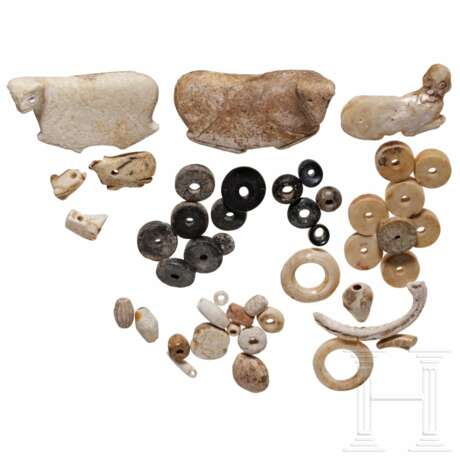Drei tiergestaltige Anhänger und zahlreiche Perlen aus Stein und Perlmutt, späte Jungsteinzeit Vorderasiens, spätes 4. - frühes 3. Jtsd. v. Chr.
19.11.2024 10:00UTC +01:00
Classic
Starting price
1400EUR € 1 400
| Auctioneer | Hermann Historica |
|---|---|
| Event location | Germany, Grasbrunn / München |
| Buyer Premium | 25 % |
Archive
The auction is completed. No bids can be placed anymore.

ID 1323259
Lot 4048 | Drei tiergestaltige Anhänger und zahlreiche Perlen aus Stein und Perlmutt, späte Jungsteinzeit Vorderasiens, spätes 4. - frühes 3. Jtsd. v. Chr.
Wohl zusammengehöriges Schmuckensemble der vorderasiatischen Kupferzeit. 1 - 3) Drei vertikal durchbohrte Figuren liegender Tiere. Zwei aus Stein, von denen das größere wohl ein liegendes Rind mit untergeschlagenen Beinen darstellt. Bei der größeren, nach rechts gerichteten Figur werden durch die Ritzungen anatomische Details dargestellt. Die kleinere, nach links gerichtete Figur glatt und abstrakter, dort die Augen aber mit präzise ausgearbeiteten, plastisch hervortretenden Rändern. Eine dritte nach rechts gerichtete Figur aus Perlmutt. Länge 4,8 - 6,5 cm. Alle Figuren mit minimalen Abplatzungen, sonst intakt. 4 - 6) Drei kleine Tierfiguren aus Stein. Bei der größeren der Kopf abgebrochen. Länge 1,8 - 2,9 cm. 7) Acht dicke, scheibenförmige Perlen aus dunkelgrauem Stein, in der Mitte durchbohrt. Durchmesser 10 - 18 mm. 8) Acht gleichartige Perlen aus hellem, beigefarbenem Stein (Calcit?). Durchmesser 16 - 17 cm. 9) Fünf dicke Perlen aus dunkelgrauem Stein mit gerundeterem Profil und teils größeren Durchbohrungen. 10) 13 weitere Perlen aus hellen Steinen in verschiedener Form, darunter doppelkonische Perlen, eine davon gerippt und eine scheibenförmig und mit Längsdurchbohrung, ferner eine kleine zapfenförmige Perle mit Spiralwindung. 11) Eine Muschel, zwei Perlmuttfragmente vom Rand größerer Muscheln und zwei aus Perlmutt geschliffene Ringe.
Provenienz: Rheinische Privatsammlung, erworben Ende der 90er Jahre bei Kölner Kunsthändler.
Three animal-shaped pendants and numerous beads made of stone and mother-of-pearl, late Neolithic period of the Near East, late 4th to early 3rd millennium B.C.
Three animal-shaped pendants and numerous beads made of stone and mother-of-pearl, late Neolithic period of the Near East, late 4th to early 3rd millennium B.C.
Wohl zusammengehöriges Schmuckensemble der vorderasiatischen Kupferzeit. 1 - 3) Drei vertikal durchbohrte Figuren liegender Tiere. Zwei aus Stein, von denen das größere wohl ein liegendes Rind mit untergeschlagenen Beinen darstellt. Bei der größeren, nach rechts gerichteten Figur werden durch die Ritzungen anatomische Details dargestellt. Die kleinere, nach links gerichtete Figur glatt und abstrakter, dort die Augen aber mit präzise ausgearbeiteten, plastisch hervortretenden Rändern. Eine dritte nach rechts gerichtete Figur aus Perlmutt. Länge 4,8 - 6,5 cm. Alle Figuren mit minimalen Abplatzungen, sonst intakt. 4 - 6) Drei kleine Tierfiguren aus Stein. Bei der größeren der Kopf abgebrochen. Länge 1,8 - 2,9 cm. 7) Acht dicke, scheibenförmige Perlen aus dunkelgrauem Stein, in der Mitte durchbohrt. Durchmesser 10 - 18 mm. 8) Acht gleichartige Perlen aus hellem, beigefarbenem Stein (Calcit?). Durchmesser 16 - 17 cm. 9) Fünf dicke Perlen aus dunkelgrauem Stein mit gerundeterem Profil und teils größeren Durchbohrungen. 10) 13 weitere Perlen aus hellen Steinen in verschiedener Form, darunter doppelkonische Perlen, eine davon gerippt und eine scheibenförmig und mit Längsdurchbohrung, ferner eine kleine zapfenförmige Perle mit Spiralwindung. 11) Eine Muschel, zwei Perlmuttfragmente vom Rand größerer Muscheln und zwei aus Perlmutt geschliffene Ringe.
Provenance: Rheinische Privatsammlung, erworben Ende der 90er Jahre bei Kölner Kunsthändler.
Condition: II +
| Auction house category: | Egypt and Asia |
|---|
| Auction house category: | Egypt and Asia |
|---|
| Address of auction |
Hermann Historica Bretonischer Ring 3 85630 Grasbrunn / München Germany | ||||||||||||||
|---|---|---|---|---|---|---|---|---|---|---|---|---|---|---|---|
| Preview | |||||||||||||||
| Phone | +49 (0)89 5472 649 0 | ||||||||||||||
| Fax | +49 (0)89 5472 64999 | ||||||||||||||
| Buyer Premium | 25 % | ||||||||||||||
| Conditions of purchase | Conditions of purchase | ||||||||||||||
| Business hours | Business hours
|


